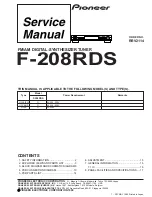
11
d) Connecting the optic cable to the RCU.
W A R N I N G HIGH VOLTAGE!
The AATU works with mains voltage 220-240VAC 50-60Hz and high DC voltage up
to 300VDC, which are
LETHAL!
Also, for your safety pull the AATU power plug out
of the mains wall outlet and
WAIT AT LEAST 3 minutes EACH TIME BEFORE you
remove any cover!
After pulling the power plug out of the mains wall outlet, using a “Philips 2” screwdriver unscrew all four side screws
from the top cover of the RCU. You will see the PCB “RCU Control” installed horizontally and having two optic
devices U3 and U4 of the same type like those you have seen yet in the remote unit (see fig.2-3). The operations on
the optic cable connection at the RCU side are analogous to those from S.2-3(d).
Unscrew the spiral cap of the plastic cable gland marked “OPTOLINK” (see fig.2-7) and thread it onto the cable
oriented with its thread towards the cable end. Push the cable into the RCU case through the cable gland and give it
some margin in order that the cable cores freely access the optic devices without straining. Now screw in the spiral
gland cap and tighten it using a wrench 15mm (19/32”). Use only enough force while tightening in order that the
cable be tight and could not slip out when pulled occasionally (do not overdo in order not to damage the plastic gland
thread).
Loose slightly the split-socket-knurled nut of the optic receiver device U3 (black housing). Then push the marked
core (S.2-4,c) that comes from the remote-unit transmitter, into the split socket. Use tweezers on need. Shove the
core against the stop, and tighten carefully its knurled nut by hand. Keep track that no foreign matter is caught into
the optic device aperture since this would obstruct the light beam.
Use only enough force while tightening in order that the cable be tight and could not slip out when pulled
occasionally (do not overdo in order not to damage the plastic case or the optic device).
Repeat the same operation with the non-marked cable core and the other optic device U4 (white plastic case).
Now install the top cover. Screw in loosely all four side screws, then make even the cover, and tighten the screws
using a “Philips 2” screwdriver. Do not push strongly along screw axes in order not to push out any captive nut from
the chassis.
e) Connect the RF coaxial cable that comes from the remote unit (with a PL-259 connector) to the transceiver output
(or the amplifier or antenna selector when available).
f) If you have options supplied, connect also their cables (KEY-IN and KEY-OUT, serial control channels COM1,
COM2 or RS422). The amplifier ACOM2000A connects via a “Null Modem” cable to the 9-contact connector COM2.
In this way, the AATU will send a “go to STBY” command to the ACOM2000A each time when you press the TUNE
button on the RCU. If the cable is not installed you should set the amplifier in STBY manually.
3. POWER ON, RCU CONTROLS AND MENU
C A U T I O N
To avoid damage (not covered under warranty), check carefully if the voltage for
which the AATU is set corresponds to your mains nominal voltage (see S.2-2).
After following all instructions in S 2, you can turn ON the Main power switch on the rear panel. The LCD back-light
and all five buttons must light (see fig. 3-1) and on the upper LCD row should appear the following message:
Connecting…
The self-test is accomplished in about 2s and then the AATU retrieves the power-on default setting – this will be
explained later in S.4-2. Now it is best to get acquainted with the menu control. Press the
Esc
button twice to reach
the main menu:













































